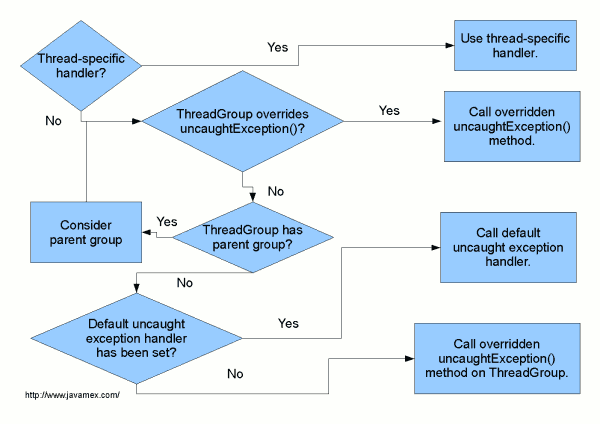前言
继之前的文章详解jvm如何处理异常,今天再次发布一篇比较关联的文章,如题目可知,今天聊一聊在jvm中线程遇到未捕获异常的问题,其中涉及到线程如何处理未捕获异常和一些内容介绍。
什么是未捕获异常
未捕获异常指的是我们在方法体中没有使用try-catch捕获的异常,比如下面的例子
|
1
2
3
4
5
6
7
|
private static void testuncaughtexception(string arg) { try { system.out.println(1 / arg.length()); } catch (arithmeticexception e) { e.printstacktrace(); }} |
上面的代码很有可能发生如下情况
- 如果方法参数arg传递null,会出现nullpointerexception
- 如果参数arg传递内容为空的字符串(“”),会出现arithmeticexception
对于上面的问题,我们不难发现
- 上面可能出现的nullpointerexception和arithmeticexception都属于unchecked exceptions
- 而arithmeticexception被我们人为try-catch捕获了,它不符合本文对于未捕获异常的定义
- nullpointerexception 由于我们没有catch住,就变成了我们要聊的未捕获异常
- 另外,未捕获异常实际是unchecked exceptions的子集
uncaughtexceptionhandler 是什么
- 它是线程遇到未捕获异常的一个处理者接口
-
它包含一个方法
void uncaughtexception(thread t, throwable e);用来处理接收处理异常发生后的操作,比如收集崩溃信息并上报等 -
可以通过 实例方法
thread.setuncaughtexceptionhandler为某一个thread实例设置未捕获异常处理者 -
也可以通过 静态方法
thread.setdefaultuncaughtexceptionhandler设置所有thread实例的未捕获异常处理者
threadgroup 是什么
- threadgroup 是线程的集合
- threadgroup 也可以包含子threadgroup
- 除了初始的threadgroup 之外,每个threadgroup都有一个父 threadgroup
- threadgroup 自身实现了thread.uncaughtexceptionhandler,用来相应处理其内部的线程和threadgroup发生未捕获异常。
未捕获异常处理者 设置指南

线程发生了未捕获异常,jvm怎么处理
分发throwable实例
当线程a中出现了未捕获异常时,jvm会调用线程a的dispatchuncaughtexception(throwable)方法
|
1
2
3
4
5
6
7
|
/** * dispatch an uncaught exception to the handler. this method is * intended to be called only by the jvm. */private void dispatchuncaughtexception(throwable e) { getuncaughtexceptionhandler().uncaughtexception(this, e);} |
获取未捕获异常处理者
每个线程会有一个变量(uncaughtexceptionhandler)来保存未捕获异常的处理者
在线程需要确定throwable分发目标的处理者时,优先获取当前线程中uncaughtexceptionhandler变量
如果出问题线程的uncaughtexceptionhandler为null(即没有显式设置异常处理者),则使用自己所在的threadgroup来作为未捕获异常处理者。
|
1
2
3
4
5
6
7
8
9
10
11
12
13
|
/** * returns the handler invoked when this thread abruptly terminates * due to an uncaught exception. if this thread has not had an * uncaught exception handler explicitly set then this thread's * <tt>threadgroup</tt> object is returned, unless this thread * has terminated, in which case <tt>null</tt> is returned. * @since 1.5 * @return the uncaught exception handler for this thread */public uncaughtexceptionhandler getuncaughtexceptionhandler() { return uncaughtexceptionhandler != null ? uncaughtexceptionhandler : group;} |
如果throwable分发给threadgroup
- threadgroup会尝试转给它的父threadgroup(如果存在的话)
- 如果上面没有找到对应的threadgroup,则尝试获取thread.getdefaultuncaughtexceptionhandler()并分发
|
1
2
3
4
5
6
7
8
9
10
11
12
13
14
15
16
17
18
19
20
21
22
23
24
25
26
27
28
29
30
31
32
33
34
35
36
37
38
39
40
41
42
43
44
45
46
47
48
49
50
|
/** * called by the java virtual machine when a thread in this * thread group stops because of an uncaught exception, and the thread * does not have a specific {@link thread.uncaughtexceptionhandler} * installed. * <p> * the <code>uncaughtexception</code> method of * <code>threadgroup</code> does the following: * <ul> * <li>if this thread group has a parent thread group, the * <code>uncaughtexception</code> method of that parent is called * with the same two arguments. * <li>otherwise, this method checks to see if there is a * {@linkplain thread#getdefaultuncaughtexceptionhandler default * uncaught exception handler} installed, and if so, its * <code>uncaughtexception</code> method is called with the same * two arguments. * <li>otherwise, this method determines if the <code>throwable</code> * argument is an instance of {@link threaddeath}. if so, nothing * special is done. otherwise, a message containing the * thread's name, as returned from the thread's {@link * thread#getname getname} method, and a stack backtrace, * using the <code>throwable</code>'s {@link * throwable#printstacktrace printstacktrace} method, is * printed to the {@linkplain system#err standard error stream}. * </ul> * <p> * applications can override this method in subclasses of * <code>threadgroup</code> to provide alternative handling of * uncaught exceptions. * * @param t the thread that is about to exit. * @param e the uncaught exception. * @since jdk1.0 */ public void uncaughtexception(thread t, throwable e) { if (parent != null) { parent.uncaughtexception(t, e); } else { thread.uncaughtexceptionhandler ueh = thread.getdefaultuncaughtexceptionhandler(); if (ueh != null) { ueh.uncaughtexception(t, e); } else if (!(e instanceof threaddeath)) { system.err.print("exception in thread \"" + t.getname() + "\" "); e.printstacktrace(system.err); } } } |
将上面的处理流程做成图的形式,就是下图所示

注:上述图片来自https://www.javamex.com/tutorials/exceptions/exceptions_uncaught_handler.shtml
questions
初始的threadgroup是什么
上面提到了初始的threadgroup没有父threadgroup,是主线程所在的threadgroup么?
这个问题,我们可以通过这样一段代码验证
|
1
2
3
4
5
6
7
|
private static void dumpthreadgroups() { threadgroup threadgroup = thread.currentthread().getthreadgroup(); while(threadgroup != null) { system.out.println("dumpthreadgroups threadgroup=" + threadgroup.getname()); threadgroup = threadgroup.getparent(); }} |
执行该方法对应的输出是
dumpthreadgroups threadgroup=main
dumpthreadgroups threadgroup=system
因此我们可以发现,初始的threadgroup是一个叫做system的threadgroup,而不是main threadgroup
setdefaultuncaughtexceptionhandler 设置的一定会被调用到么
这其实是一个很好的问题,答案是不一定会被调用,因为可能存在以下的情况
- 出问题的线程设置了对应的uncaughtexcpetionhandler,优先响应分发到这个handler
- 出问题的线程所在的threadgroup包括其祖先threadgroup 重写了uncaughtexception 也可能造成线程默认的handler无法被调用
- 出问题的线程重写了dispatchuncaughtexception 可能性较小
- 出问题的线程重写了getuncaughtexceptionhandler 可能性较小
参考声明
how uncaught exceptions are handled
总结
以上就是这篇文章的全部内容了,希望本文的内容对大家的学习或者工作具有一定的参考学习价值,如果有疑问大家可以留言交流,谢谢大家对服务器之家的支持。
原文链接:https://droidyue.com/blog/2019/01/06/how-java-handle-uncaught-exceptions/















